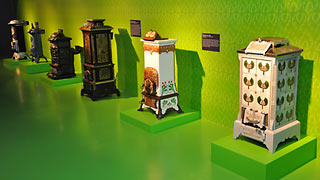Brennpunkt° - Collection
- Fire creates heat
- The well-tempered city
- Planet of the fire makers
- The art of heating
- Café Mustapha
- Beautiful stoves
- Nice and cosy
- Dripping and sizzling
- Smoking heads
- Squishy clean
- Energy of the future - the future of energy
1. Fire creates heat
There are different ways of heating your home - you can go it alone if you are self-sufficient, or connect to the local district heating grid or similar complex systems.
2. The well-tempered city
A large city like Vienna is not just about heating and cooling living spaces. Public facilities like schools, municipal offices, hospitals, public pools and even abattoirs need to be kept at the right temperature at all times. Some like it hotter, others cooler, some need heating or cooling all the time, others at certain times only. Proper heat supply can be a challenge.
3. Planet of the fire makers
Fire serves us in many different ways. It provides heat and light. We use it to process raw materials, or to make food more durable, tastier and more easily digestible. A large map of the world on the wall illustrates how fire is made in different parts of the globe. These techniques differ from culture to culture, while methods to keep the fire burning and put it to use tend to be much more universal.
4. The art of heating
Heating is an art. The more scarce energy becomes, the more important it is to master this art. Heating an office building, a school or even a hospital requires sound knowledge of fuels, material properties, types of heat, and the operation of large boiler plants.
5. Café Mustapha
There is a lot of poetry in heating too. Just think of a specific stove or heating apparatus you remember in a particular room, the effort it took to get it going, the peculiar sounds, smells, colours or even light effects it produced. Heating appliances blend into and become one with their environment over time.
6. Beautiful stoves
Stove manufacturers in the late 19th century took great pains to turn their stoves into beautifully shaped and colourful pieces of furniture. Fine-iron casting helped them to produce intricate decorations and small parts in great numbers.
7. Nice and cosy
Perceptions of what is considered "cosy" have changed over time. In the old days, room temperatures between 16 and 18 degrees Celsius were quite usual, and many rooms were not heated at all. Today most of us enjoy the comfort of a central heating system, yet there is nothing like an open fireplace or tiled stove to give us that extra cosy feeling.
8. Dripping and sizzling
Bathrooms and kitchens – the "wet units" in our homes have undergone considerable changes over the past century, and the trend is likely to continue in the future.
Unlike kitchens, separate bathrooms are the most recent addition to our homes. For centuries, people simply placed large bathing tubs or bowls in their rooms when they needed to wash and keep themselves clean.
The stove or cooking area, by comparison, has been the hottest spot in the home since time immemorial. This part of the home was always warm, and took up a lot of space in the old days. Built-in kitchen stoves that are common today only appeared in the 20th century, when gas and electricity became available and made it easier to control heat.
9. Smoking heads
Minds and brains, too, need the right operating temperature. Schools today make sure it is set properly. In the old days, however, some schools would heat their classrooms one at a time. In times of hardship they had to cut back on coal. Still, many children were warmer at school than they were at home. Occasionally pupils had to help with the heating..
10. Squishy clean
Doing your laundry used to be a tremendous effort, so people would often get together on special days for these chores. Wealthy people had the option of leaving the work to professionals, the so-called laundrettes and their famous washerwomen.
Modern chemistry and its applications started making life and laundry chores significantly easier. More than 150 years ago, laundry detergents were already in use to bleach, clean and soften the water, but the tedious tasks of wringing and spinning the laundry still had to be done manually. The first washing machines provided some relief from this, but it took many developments to optimise them and come up with the washing machines we know today. It was not until the 1960s, when washing machines became less heavy and more affordable, people increasingly started doing their laundry at home instead of in the washhouse.
11. Energy of the future - the future of energy
Which technologies will heat our homes in the future? How will we generate electricity? What energy sources are available to us, and how can we use them in the most environmentally friendly way possible? What new forms of energy are scientists researching?
Large infographics provide answers to these questions by illustrating basic operation modes and the specific situation in Vienna. Interactive games and films focus on key issues like saving energy, new storage media, or the way a heat pump works.
City of Vienna | Brennpunkt° - Vienna's Museum of Heating Customs
Contact form












